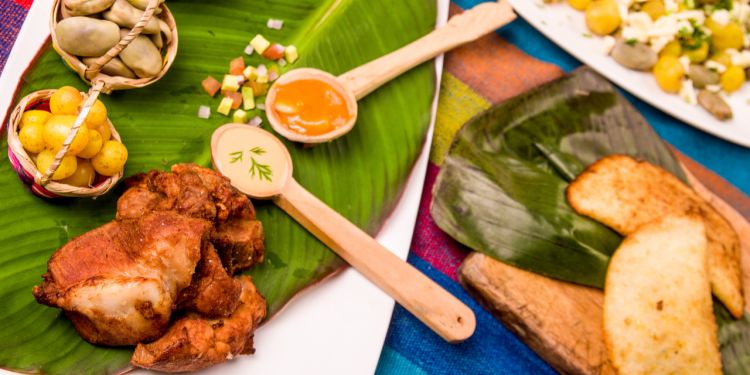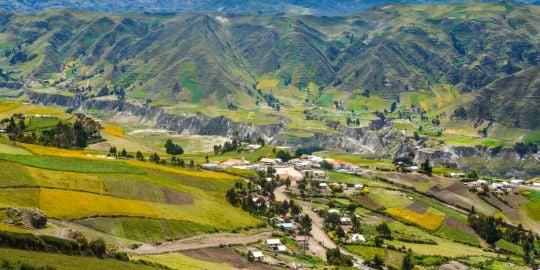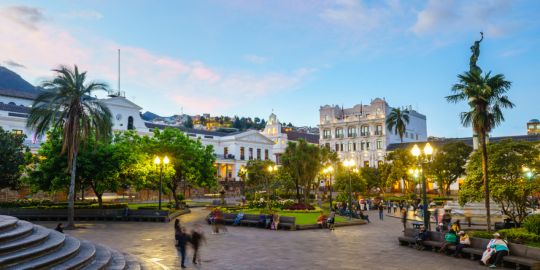Food and cuisine in Ecuador

What kind of food will you find in restaurants, cafes, and private homes in Ecuador? Many restaurants in Ecuador offer various types of ethnic food, just like all over the world. But what is typical Ecuadorian food? With the wide variety of fruits, vegetables, seafood, and meats, you will surely find something to suit your taste.
Fruits and vegetables
You won't have any problem getting your daily requirement for fruits and vegetables in Ecuador, such is the wide variety of foods grown here. As there is year-round warm weather, farmers can grow numerous crops per year in any field. Food is grown and consumed locally, if not exported. Ecuador has become a major exporter of many fruits, such as Dragon Fruit (known here as 'pitahaya'), melons, pineapples, mangoes, jackfruit, soursop (aka 'guanabana'), Andean goldenberry, mortiños (wild blueberries), kiwis, as well as bananas. Freshly squeezed juice, either orange, pineapple, melon, blackberry, or strawberry always accompanies both breakfast and 'almuerzo', or lunch. As for vegetables, the rich volcanic soil produces wonderful and tasty lettuce and cabbage of all varieties, as well as tomatoes, peas, onions, cucumbers, cauliflower, broccoli, beets, radishes, carrots, cilantro, celery, parsley, green beans, jicama, asparagus, artichokes to name a few. Sugar cane is grown and harvested in the wetter coastal areas and is the source for 'Panela' (unrefined brown sugar). 'Panela' can be found in all stores and markets in Ecuador, and is a tasty, healthier alternative to white sugar. Let's not forget the potato, which originated in Ecuador in the Andes mountains. Potatoes come in all shapes and sizes in Ecuador: brown, yellow, red, pink, mottled; big, fat, skinny, tiny, fingerlings. Some are considered only for soups (oca) while others can be baked, broiled, fried, or riced. In the Andean mountain areas, 'llapingachos' are an ancient delicacy: a thick potato pancake, made from mashed potatoes, seasoned, and then quickly fried on both sides.
Rice, Plantains, Bananas, Mote and Yuca
Rice has been a staple of the Ecuadorian diet for as long as anyone can remember, both along the coastal regions and in the mountainous areas. White, starchy rice forms part of almost every 'almuerzo' or luncheon plate, and a large scoop of rice accompanies most meals. In stores, you can buy brown rice, white 'new' rice, and even aged rice, which is considered the tastiest.
Ecuador is a worldwide exporter of sweet bananas, but did you know that bananas come in many forms, shapes, colours, and flavours? 'Guineos' are sweet bananas; 'platanos' are hard, starchy, non-sweet bananas that are cooked in a soup like potatoes or baked like bread; 'oritos' are tiny, three-inch-long sweet bananas that are a delicacy. You can also find red bananas, considered the sweetest of them all. Bananas are grown all along the coastal areas, and the ones that are consumed in Ecuador are not 'gassed' to be ripened but are usually sold green and take a day or so to ripen.
Yuca is a stringy, starchy tuber similar to a potato, and is also known as tapioca. It grows all over Ecuador. They can be boiled, eaten in soup, or baked for a starchy bread-like accompaniment to meals. Yuca bread is a favourite in Ecuador, baked using the yuca starch this is made into flour, and are very tasty, particularly when served with cheese.
Mote is a white, starchy, hominy type of corn that is grown and mostly eaten in the mountainous areas. Ecuadorians cook mote many ways: boiled in soup, boiled and then roasted like corn on the cob and eaten with crumbly fresh cheese; or popped like popcorn, often served as an appetizer.
Meats and poultry
Ecuador has managed to perfect the best pork in the world, and you can find pork roasting in all the mercados and on every restaurant's menus. 'Chancho Hornado', or roasted pig, is such a favourite country-wide that there is a cook-off every year throughout Ecuador, and the President is called on to help with the finalists. Don't miss out on this delectable, marinated, and slow roasted meat as it is delicious, usually served with pan-fried potatoes, sliced onions, and more.
Chicken is sold and eaten everywhere in Ecuador. You can never go wrong buying a fresh chicken to bake or simply buying an already roasted, marinated chicken at the many chicken places in every city in Ecuador.
Beef in Ecuador is grass fed, therefore much leaner than grain-fed beef. Also, beef is not usually aged in Ecuador for as long as in Europe, North America, or even Argentina, but it does have an excellent flavour. Better restaurants in the larger cities have managed to find butchers who will cut beef to exacting specifications and will often age the beef themselves. A suggestion is to avoid beef in restaurants that are not relatively more expensive gourmet ones. Save your taste for beef for the more expensive restaurants in Quito, Guayaquil, and Cuenca.
Cuy (guinea pig) is a delicacy only in the Andean mountain regions. Cuy can be bought and eaten after being roasted on a large spit in all of the mercados in small and larger cities all along the Andean spine. Most indigenous markets will offer cuy, ready for roasting, alongside chicken also ready for the cooking pot. The taste is similar to chicken, and it's a cultural experience that should not be missed.
Seafood
Fishermen all along the coastal areas take their small boats out every day and bring back the freshest of the fresh. Fish markets in Salinas, Manta, Bahia, and even the smaller towns along the coast offer a whole host of just caught seafood. Tuna, Mahi-Mahi, Paiche, Corvina, and swordfish are just a few of the many fish options on offer. Prefer shellfish? Small, warm water Pacific lobsters, sweet stone crabs, soft shell crabs, and black mussels can be found almost every day. There is a moulting season where it is forbidden to sell blue and red crabs, usually around August and September, so beware during those months. Shrimp are caught wild everywhere in the coastal waters, and shrimp farms are ubiquitous near the mangrove swamps around Guayaquil and Machala, on the southern coast, but these are mostly grown for export.
Beans and lentils
Beans and lentils have become popular over the last 20-30 years as Ecuadorians have learned that they can be easily grown, harvested, dried, and stored for a long time. A popular meal is a fried chicken leg with a plate of cooked and spiced lentils. Peanuts grow well in the volcanic soil of the Andes, and can be found in soups, stews, and even in sauces. All stores and markets offer a great selection of beans: white, red, pink, black, big, and small.
Grains
Quinoa was known to be a staple of the Incas long before it became popular in other countries, and as it has a higher protein content than any other grain, has become a valuable health food. Nevertheless, quinoa is still a staple of the indigenous diet in Ecuador, in soups and stews as well as salads. Other grains grown in Ecuador are amaranth, whole wheat, barley, corn, soy, and rye. Not always thought of as a grain, but very important to Ecuador are palm kernels that are made into palm oil, coffee beans, and cocoa beans, all of which are heavily exported. Ecuador has become known for excellent chocolate and most recently won numerous awards for a few Ecuadorian manufacturers and exporters of fine chocolate.
Sauces
Ecuadorians love their sauces. Every restaurant will have their own version of 'Aji' or spicy garlic sauce. Some are spicier, some more onion-like, while others have lots of garlic, but none will be bland. Potatoes can often be accompanied by a special indigenous sauce made from roasted and ground pumpkin seeds, garlic, and spices. Fresh garlic can be found everywhere, and many restaurants will make their own garlic spread made from mild fresh garlic whipped with seasonings and oil into a most delectable vegan alternative to butter. Cilantro and parsley grow wild and are often mixed with finely chopped onions and tomatoes for a wonderfully tangy topping for bread or meat.
You will never go hungry, where ever you stop to eat in Ecuador! Enjoy the delicacies, produce, and cuisine. Ecuador is a foodie paradise.
Useful links:









